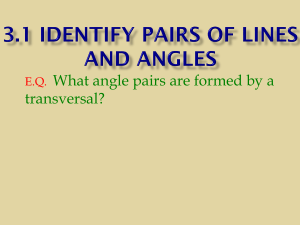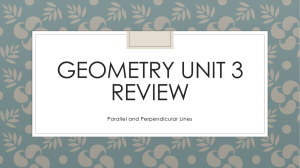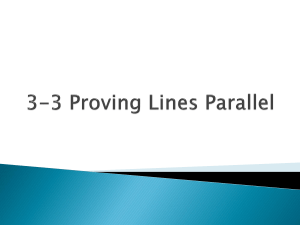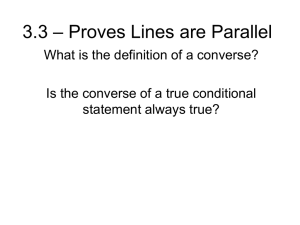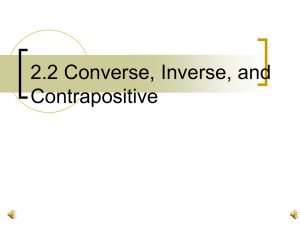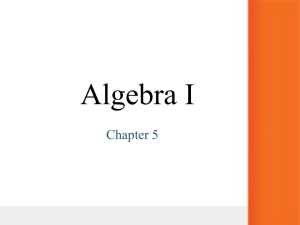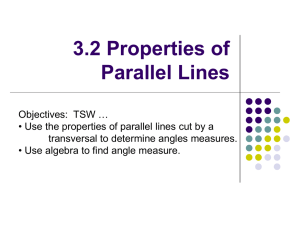Geometry Chapter 2
advertisement
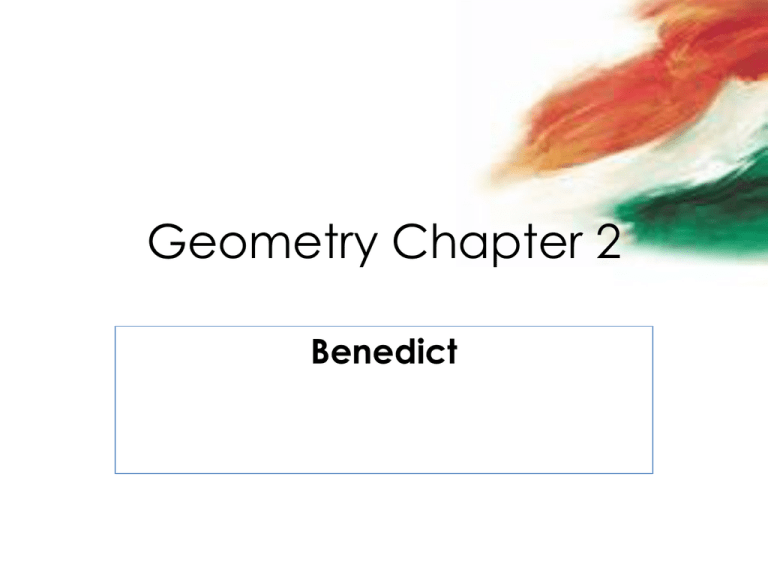
Geometry Chapter 2 Benedict Warm Up 12 1. The _____ of a conditional statement is found by switching the hypothesis and conclusion. 2. Write the hypothesis and conclusion of the statement; “If the dew equals the air temperature, then it will rain.” 3. Write the statement in if-then form. The measure of a right angle is 90 degrees. Re-teach 12 Conditional statement- two parts; a hypothesis and a conclusion. Statement written in “if-then form”, the “if” is the hypothesis and “then” is the conclusion If it is a block day, then it is a Wednesday or Thursday. Re-teach 12 Negation- writing the negative of the statement Wednesday is not a block day Contrapositive- negating the hypothesis and the conclusion of the converse Practice 12 Directions: Rewrite the conditional statement in if-then form. Three points are collinear if they lie on the same line. Beating LM gets us a half day on Monday. Closure 12 Directions: Write the converse of the statement. If the angle measures 38°, then it is acute. I will go to the movies if it is raining. Warm Up 13 Directions: Use the graph on the flashcard to answer the questions. 13. Points A, F and G are collinear. 15. DC is perpendicular to line l. 17. < FBJ and <JBA are complementary. 19. <ABJ and <DCH are supplementary. Practice 13 Directions: Rewrite the biconditional statement as a conditional statement and its converse. 23. A point is a midpoint of a segment if and only if it divides the segment into two congruent segments. Directions: Give a counterexample that demonstrates that the converse of the statement is false. 25. If two angles measure 42° and 48°, then they are complementary. Closure 13 Directions: Find the measures of a complement and a supplement of the angle. 87° Warm Up 14 Directions: Find the distance between the two points. Answer will be a decimal. 35. A (4, 5) B (-3, -2) Directions: Given the endpoint and the midpoint of the segment, find the other endpoint. 41. B (5, 7) M (-1, 0) Practice 14 Directions: Pair up and complete problems 31-35 on the flashcard. Re-teach 15 Parallel lines- coplaner lines that do not intersect. Skew lines- lines that are not coplaner and do not intersect. Transversal- line that intersects two or more coplaner lines at different points. Re-teach 15 Alternate Exterior Angles- lie outside two lines on opposite sides of the transversal. Alternate Interior Angles- lie between two lines on opposite sides of transversal. Consecutive Interior angles or Same Side Interior Angles- lie in between two lines on same side of the transversal. Re-teach 15 Corresponding Angles- Angles in matching corners are called corresponding angles. Practice 15 Directions Use the following graph to identify – Corresponding Angles – Alternate Exterior Angles – Alternate Interior Angles – Consecutive Interior Angles/Same Side Interior Warm Up 16 Directions: Find the value of x. Practice 16 Directions: Work with a partner to solve the problems on the worksheet. When finished turn it in to the bin. Warm Up 18 Directions: Find the value of x. Explain what makes r and s parallel. Practice 18 Directions: Work together to solve the problems on the worksheet. Re-teach 19 Slope Finding slope: (-2, 7) (3, 2) Re-teach 19 Equation of a line Solving for b (-2, 7) (3, 2) Practice 19 Find the slope of the line and then create an equation of the line for the following points. 5. (2, 5) (4, 1) Practice 19 Find the slope of the line. Determine if the points are parallel. 17. (-5, 9) (-1, 1) and (0, 7) (3, 1) 19. (0, 4) (-2, -2) and (4, 2) (2, -6) 21. (0,7) (-6, 2) and (5, 1) (-2, -4) Practice 19 Find the slope of the line. Determine if line AC is perpendicular to line BD. A (-1, -2) C (0, 1) and B (-3, 2) D (3, 0) A ( -2, -1) C (4, 1) and B (-2, 3) D (0, -2) Closure 19 Directions: Explain whether the lines are perpendicular, parallel or neither. y = -2x – 1; y = -2x – 3 y = -1/2x + 3; y = - 1/2x + 5 y = -3x + 1; y = 1/3x + 1 y = 4x + 10; y = -2x + 5

